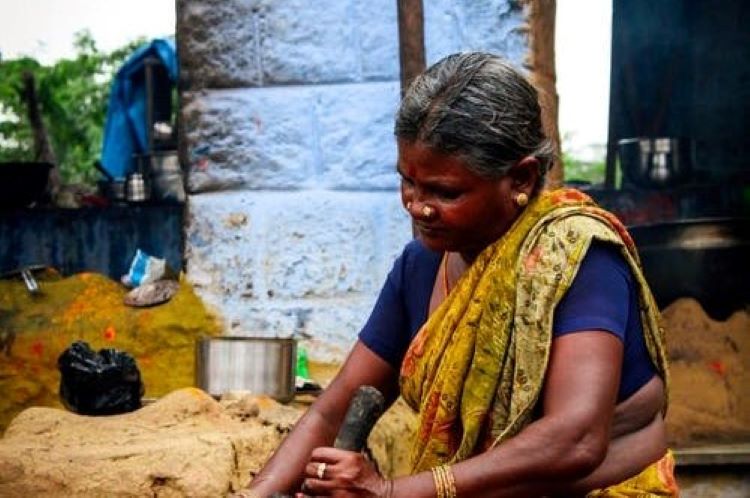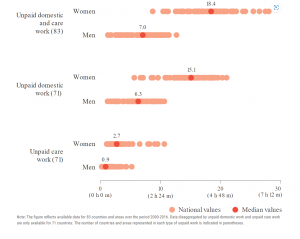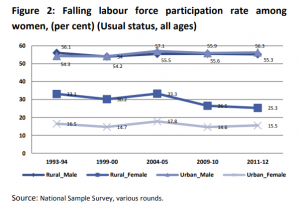
The latest Global Gender Gap Report 2022 of the World Economic Forum has ranked India at 143 among 146 countries in economic participation and opportunity. There are several reasons for the gender gap in workforce, but the report highlights the impact of the Covid-19 pandemic which affected women disproportionately by reducing sectoral employment opportunities and increasing the domestic and care work for women. In fact, the lockdown affected services sector, retail trade, and hospitality, where women workers are concentrated, apart from the unpaid care work imposed on women.
Globally, women’s share of time spent in unpaid work as a proportion of the total work is 55% while for men it was only 19%. (GGR 2022). Another report by the ILOSTAT in 2022 says that during the pandemic, around 2 million mothers across the world left the labour force because of the increase in unpaid care and domestic work that rose 1.6 times.
READ I COP27: Urgent need to focus on health impact of climate change
Unpaid women workers and SDG 5.4
One of the prominent targets for achieving gender equality under Sustainable Development Goals (SDG 5), Target 5.4 is recognizing and valuing of unpaid care and domestic work through the provision of public services, infrastructure, social protection policies and promotion of shared responsibility within the household and the family.
The pressures of unpaid and care work often constrain women from participating in full time paid employment. They tend to opt for low paying, irregular jobs mostly informal in nature, particularly in countries like India. This restricts their upward mobility and often deprives them of adequate income and social security. The Time Use Survey Report of India 2020 (TUS) says women spend more than 05 hours in unpaid domestic services for household members and more than 02 hours in unpaid care giving services.
The gender gaps in participation were quite prominent with men spending only slightly more than an hour in unpaid domestic and care giving activities. At the same time, men spend at least 08 hours in employment and related activities while women spend slightly more than 05 hours. Also, women have less time to pursue leisure activities while men could spend more time.
READ I Wheat exports: Uncertainty looms despite Russia’s re-entry into deal
Motherhood penalty
Data obtained from TUS also reveal that the unpaid work share is higher for married women (96%) and widowed/ separated and divorced women (79%) than women who were never married (68.4%). Marital status, presence of children and household size are important indicators to understand household division of labour. A study conducted by the World Bank Motherhood Penalty and Female Employment in Urban India pointed out that women having children of pre-school age are most likely to drop out from the labour market or opt for low-paying informal jobs.
Proportion of time spent on unpaid domestic and care work

Further, the Covid-19 pandemic had differential impacts on men and women. Women’s unpaid work burden had increased considerably. A report of the OECD in 2021 says mothers are nearly three times as likely as fathers as they took on the majority of additional unpaid care work due to the closure of schools and childcare facilities. It is also observed that gender gaps in employment was highest for women who had children below 12 years of age.
The report points out that women workers experienced disproportionately more stress during the pandemic than men. However, women had been spending a considerable amount of their time in unpaid care work even before the pandemic. Women, in many developing countries including India tend to get engaged in multiple activities which often leads to time stress and affects their well-being.
The Time Use Survey Report 2020 had tried to capture multiple activities and had highlighted that around 40% women who were participating in unpaid domestic services for household members were engaged simultaneously in the same activity as a multiple activity. The capturing of multiple activities provides deeper insights into women’s work and also highlights the contexts in which they multitask.
The Beijing declaration
These insights are critical from a larger policy perspective to address the invisible challenges that women workers face to participate in paid work and also towards achieving target 5.4 of the SDGs. The TUS has been an important survey in many countries for addressing the challenges associated with women’s unpaid work.
Though the Beijing Declaration and Platform for Action in 1995 had recognized the need for policies to harmonize work and family responsibilities for promoting equality, women have been engaged in more unpaid work such as domestic work and care work, compensating for lost household income when public services are not available. As discussed earlier, women predominate in certain sectors and lack of policies on employment protection and social security (including childcare) often discourages them to continue in employment.

From a broader policy perspective, the participation of women in unpaid work cannot be ignored. The pandemic has further necessitated the need for uncovering the inequalities in unpaid care work for designing public policies. It is important to revisit the sectors with large presence of women through targeted inventions for promoting and supporting jobs in these sectors and providing access to adequate social protection.
Towards achieving the target 5.4 of the SDG, it is it is important to focus on employment generation and reduction in unpaid work. Such efforts may include larger social sector funding, investments in infrastructure, energy, water (near to residence) etc that can contribute in reducing unpaid work for women and enable them to spend more time in paid work.
The TUS have broader policy implications, particularly in terms of understanding the differences in men’s and women’s experiences, as well as uncovering gender inequalities in household division of labour. The visibility of unpaid work in official statistics enables in policymaking in the direction of unpaid work reduction and redistribution. The TUS need to be conducted at regular intervals along with well-defined indicators to capture multiple activities for effective policy making towards promoting gender equality.
(Dr Ellina Samantroy Jena is Faculty Co-ordinator, Centre for Gender and Labour, at V.V. Giri National Labour Institute.)
